Linen is SLUBBY. There’s no way to get around it. Some linens have fewer slubs than others, but linen and slubs just go together. In linen fabric, slubs can be pesky; in linen thread, they can be downright maddening. Well, until you remember it’s linen… and slubs and linen just go together…
A slub is a little lump in thread (or yarn or fabric) that develops during the spinning process, when loose fibers get caught up in the thread being spun. “Slub” is a magnificent word. When I hear it, the word “slug” automatically comes to mind. There are two reasons for the connection: 1. slubs look like slugs, in a fibery sort of way; and 2. slubs in thread try my patience and make me want to slug… something, someone, anyone!
But then I remember… slubs and linen just go together.
On my needlebook project, Londonderry Linen thread is used for the edging around the needlebook. Before assembling the book, the instructions require backstitching all around the edge of the needlebook, using black Londonderry Linen thread. Once the mitering is done on the cover of the book, I think I am supposed to go back to those backstitches and work a scalloped buttonhole needlelace in them, using the same thread.
And I don’t mind using Londonderry Linen thread! As linen thread goes, I like it a lot.
But if you’ve never used linen thread, you should prepare yourself for the experience. You should know that slubs and linen just go together.
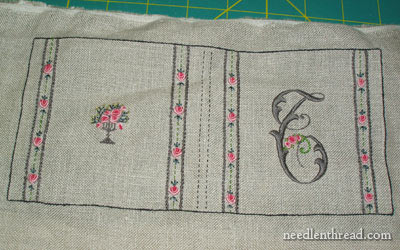
I backstitched all around the outside edge of the needlebook.
It was a lot like writing with a bloppy pen. You can see where the black stitching is a bit thicker-looking, can’t you?
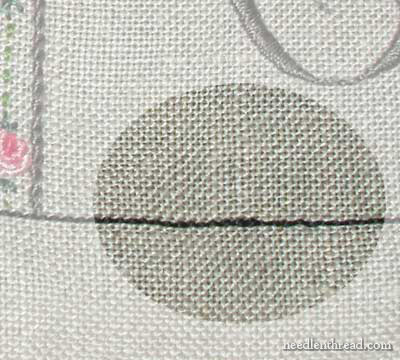
In places like this, for example?
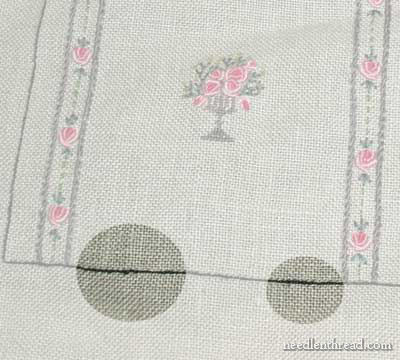
Or in places like these?
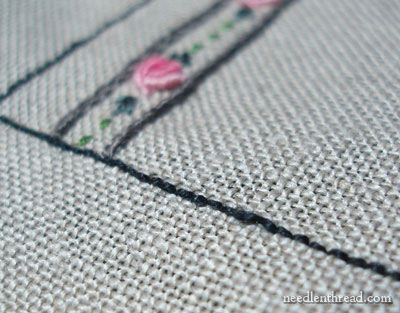
See?
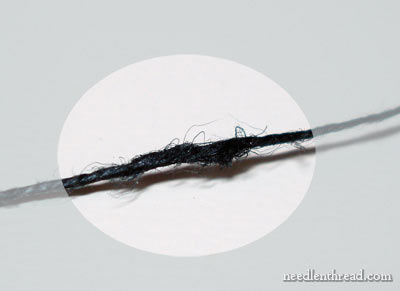
This is the culprit. It is a slug. No, no – sorry – it’s a slub. And slubs and linen… they just. go. together.
But you know, you can take a stand against slubs. They can be conquered. When I find them on thread, and I see that they are an obvious protrusion from the thread, I take a needle and try to pick them out, or, if it’ll work without cutting the thread, I take my scissors and I trim them. I do! And when I find them in fabric, if they interrupt the design and I can do it without damaging the fabric, I carefully pick them out with a needle and tweezers. But you know, sometimes I think I might be damaging the character of the linen.
But if you find that slubs really frustrate you when you’re stitching – because on linen thread, they can be frustrating! sometimes they’re like pulling a small knot through the fabric! – just calm down and remember that they both (slubs and linen) just go together.
Have you experienced slubs? What do you do about them?







Oh, yes!
Sometimes I had to count till ten…or twenty!!!
I've done all the embroidered drawn threads with linen thread! But the result is much more beautiful – I think – than if I've used cotton thread.
as you say linen and slubs just go together
I use linen floss alot for Blackwork. When using linen-on-linen it can look very woven-in and embedded; which I think is beautiful. But for you, Mary, someone who specializes in smooth silk thread painting, I can understand your feelings. Why don't you change the thread to cotton floche or pearl? That may solve the issue.
I agree. Slubs are part of the character of linen. Occasionally, though, I'll find one that's just a bit too big. These really show up if you're doing cross stitch; suddenly you'll have a cross that's much bigger than its neighbor, due to a slub in the linen fabric. For these, I use a really sharp pair of tweezers and gently tease out the worst of the slub, then cut the linen "hairs" with scissors held parallel to the fabric (to avoid cutting the fabric itself – just the wisps!).
I know linen has slubs, but I think that is part of it's beauty. I don't enjoy stitching on evenweave, it's too even. I get bored. I had a piece of antique linen that I stitched a sampler on, and a couple of times, embedded in the slub was a small piece of straw or chaff. I was able to tease thouse out of the weave and continue, but it gave me a little perspective on linen weaving.
I really enjoy your blog, and I'm collecting the instructions for the lettering sampler. I have a design started, but I haven't transfered it to fabric yet. It would be interesting to see a picture of the sampler with a size reference. I can't really tell how big it is from the pictures.
Thank you again!
Jane
If the slub is in the middle of a long length of thread, I take the needle to the back of the fabric and run the thread under the completed stitches until I've used up the part of the thread with the slub. (If I'm doing a technique where that's feasible.) If I'm closer to the end of the thread, I'll just end it sooner than I would have otherwise, so I don't have to stitch with the slubby part.
Hi Mary, thank you for your post, it's good to know that this can happen before I start experimenting with linen.
I've decided life is too short for the frustration of linen thread. I gave it all away and refuse to buy more.
Yes, linen is linen. And part of its natural beauty is the unevenness of it. In the case of this needlebook, I liked the "look" of it for the edging. The linen takes the dye different that silk does (no big news there!), so I liked the quiet "noir" as opposed to something shiny. I can understand why someone might want to substitute — as previously suggested. I would suggest a good substitution to be Soie Perlee in Noir. Coton Broder and/or Perle Cotton are not "tough" enough for the edge-abuse and over time they will get fuzzy and shred.
Thanks for your comments and suggestions, all!
Actually, I should probably have been a bit clearer – I do LIKE the linen, and I'm looking forward to finishing the edge with it. I think it looks good with the whole piece. I can't wait to do the finishing around the edge!
Only to wish you a Merry Christmas and to thank you. I am a beginner needleworker and am totally awestruck…yet…this is important NOT overwhelmed. Your instructions and pictures make it all seem possible…but it is your commentary that I so enjoy. It is like you are right here and just chatting away. Please, just keep up the wonderful work.